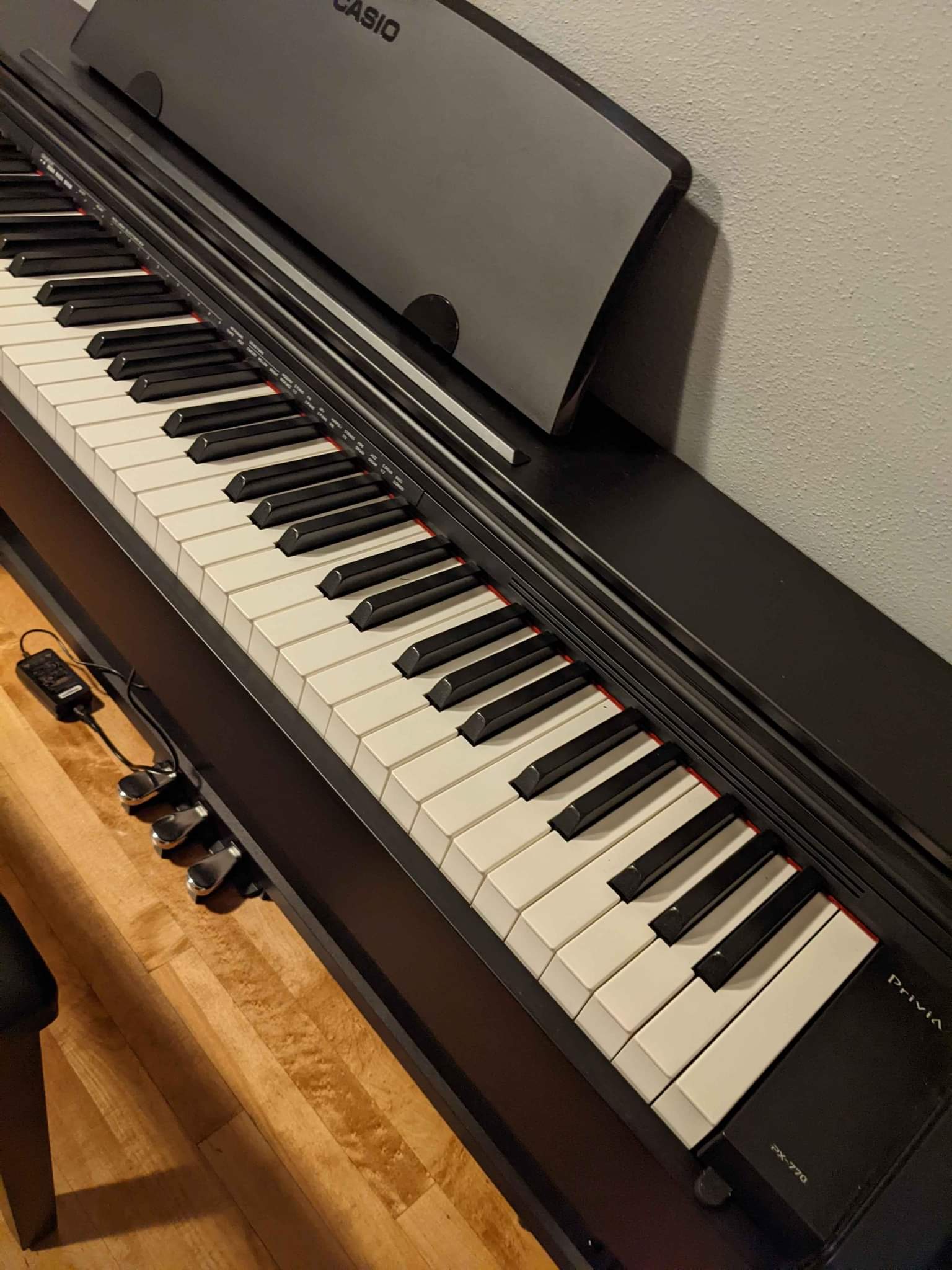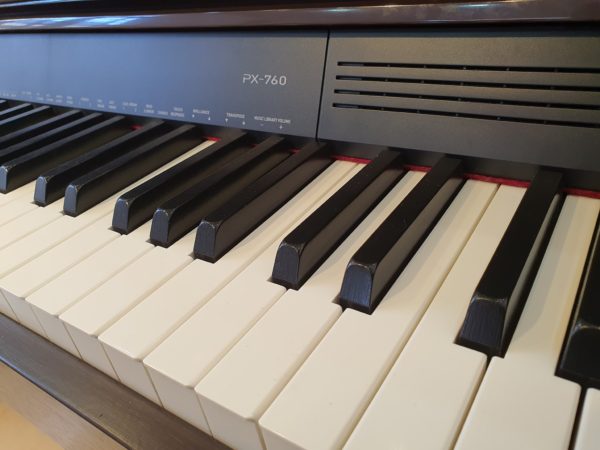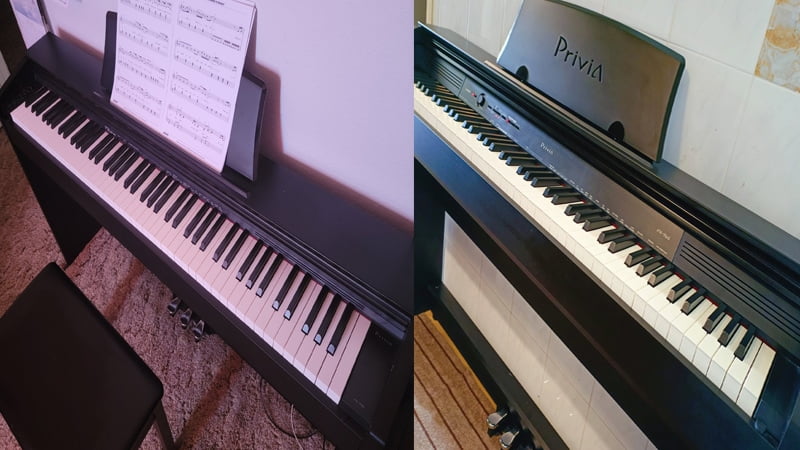Find out the superior Casio Privia console digital piano option in this Casio PX-770 vs 760 review and comparison!
The Casio Privia line is pretty famous in the world of pianos. This collection of digital console pianos has a model for everyone. But in this Casio PX-770 vs 760 review, we’ll only be focusing on two of them.
The Casio PX-760 used to be the top affordable option in the Privia line. And even today, the piano still holds up with its extensive range of features, realistic piano feel, and great tones.
However, when the Casio PX-770 came along, the PX-760 had to step aside. The Casio PX-760 can be seen as an upgrade over the 760. It keeps all the good features of the PX-760 but it comes with a bit more versatility with a wider sound library and more effects options.
While both pianos will serve you fairly well, I had to choose the Casio PX-770 as the definite winner because of the extra versatility you get by investing in this model.
Casio PX-770 vs PX-760: Comparison Chart




Last update on 2025-07-08 / Affiliate links / Images from Amazon Product Advertising API
Casio PX-770 vs PX-760: The Features
There are many ways to compare digital pianos. But for this comparison, I figured the easiest way to get an objective winner is to compare each of the features. While it was a close-knit battle, at the end of it all, the Casio PX-770 came out on top with a score of 3-1.
With a wider sound library and better effects, it had that extra bit of versatility which launched the Casio PX-770 far ahead of the PX-760. And while the PX-760 is still a great piano for just about anyone, it couldn’t compete with the PX-770’s versatility.
Tone
The winner: Casio PX-770
In terms of tone, both the Casio PX-770 and the PX-760 sound the same. After all, they use the same tone generation technology. However, the main difference between the two is the sound library. While the PX-770 doesn’t have that much more voices than the PX-760, it is enough to declare the PX-770 the winner in this comparison.

+Tone Generator
Both of these pianos use the AiR Sound Source. This stands for Acoustic and Intelligent Resonator. While this may sound complicated, it works just like any other digital piano in this price range. These pianos are loaded with high quality samples or recordings of real acoustic instruments, and whenever you press a key, a sample is triggered.
The difference though is the AiR Sound Source uses dynamic sampling. This means that there are four different samples being played every time you press a key. This is specifically designed to better emulate the sound of an acoustic piano.
With this technology, the sound travels through the air in a more realistic way. That way, when it hits the player’s and audience’s ears, it’s just like an acoustic piano.
When listening to these pianos, the sound quality blew me away. For their price, it easily beats out a lot of the competition. And since both pianos have the same tone engine, you’re assured of high-quality sounds whenever you press on a key.
+Sound Library
So, if these pianos have the same tone generator, why is the Casio PX-770 the winner? Well, that’s simply because of the sound library.
For a digital piano, the Casio PX-760 already has a fair amount of tones. This model is loaded with 18 different voices. So, you get different choices for electric and acoustic piano voices, organ voices, strings, synths, and even bass sounds. And compared to other digital pianos in this price range, this is a fair amount of voices.
However, the Casio PX-770 has a sound library with 19 different voices. The extra voice you get with the Casio PX-770 is a rock piano. This is an acoustic piano that is more geared towards heavier music like rock and roll and blue.
Granted, this isn’t a large difference, however, it does give the Casio PX-770 a bit more versatility, which is why it was the winner in this comparison.
Feel
The winner: Tie
One of the things that made the Casio PX-760 stand out upon its release was the feel. Musicians really enjoyed that this piano had shared a similar feel to an acoustic piano. Casio understood this and made sure to keep that exact same feel on the Casio PX-770, which is why these two options are tied in this category.
+Hammer Action
The Casio PX-760 and the PX-770 feature scaled hammer action. This is a type of hammer action that is designed to replicate the feel of an acoustic piano. So, when you play either of these pianos, you can expect slightly heavier keys on the left side compared to the right side.
This is a great feature for any pianist whether you’re a beginner or professional musician. This is because the scaled hammer action feels very close to an acoustic piano. So, you can easily switch between the two instruments without having to adjust.
Additionally, when learning the piano and practicing at home, it’s important to practice on an instrument that simulates the feel of acoustic pianos. That way, you get used to the weight of the keys and train your muscles properly.
And if the weight is a bit too heavy for you these pianos have adjustable touch response. This doesn’t change the weight, but it does change the sensitivity of the keys so you can make slight tweaks if you have lighter or heavier hands than usual.
+Key Texture
Another area where these two pianos shined is key texture. Both of these pianos have textured keys. While they are made of plastic, they do feature a certain coating that’s designed to replicate the texture of ebony and ivory.
This coating is called “Ivory Touch” and it’s most noticeable on the white keys. My main complaint with a lot of pianos in this price range is that the plastic and glossy keys don’t feel great when playing.
And while the texture on these keys isn’t exactly the same as wooden acoustic piano keys, it is much closer than if the keys featured no coating at all.

Piano Features
The winner: Casio PX-770
Both of these pianos feature the same playing modes. Afterall, pianists appreciated the versatility of the PX-760, so why change anything with the PX-770. However, the difference is that the PX-770 has more effects, which is why it ultimately won out in this category as well.
+Playing Modes
Both pianos feature three different playing modes: dual (layering), duet (lesson), and split mode. If you’re a piano student or even a serious musician, these are all the playing modes you will need with the instrument.
Dual mode combines two different voices to create a unique tone. This is great if you play with other musicians as an accompanying pianist. With duet mode, you can split the piano into two “mini-keyboards” with the exact same tone, timbre, and pitch. So, you can play as if you had two separate pianos, which is great for piano lessons and certain pieces of music.
Lastly, split mode allows you to load two separate voices at the same time. For example, you can load a bass voice on the left side of the piano and an organ voice on the right side of the piano. That way, you can play two musical roles at the same time and fill in more space.
Additionally, both of the pianos have a recording function. Keep in mind that this is a MIDI recording, so it won’t be studio quality, but it is good enough for you to record yourself playing and listen back to find where you made mistakes.
+Effects
The Casio PX-760 comes with reverb and chorus effects. The Casio PX-770, on the other hand, comes with both of those effects plus a Brilliance effect. This is a pretty subtle effect and most beginners will have a hard time noticing the difference.
However, this subtle effect gives pianists a whole lot of control over the sound and tone of their instrument. So, you can make small tweaks and adjustments to your tone until you find the right settings that perfectly suit your playing style.
Casio PX-770 vs 760: The Similarities
These two pianos are from the same brand and product line, so they share a lot of similarities. With these pianos, you get the same tone generator, same hammer action, and even the same playing modes.
The Casio PX-760 came out before the PX-770. And at the time, it was largely considered the best digital console piano in its price range. However, the Casio PX-770 took all the good parts of the PX-760 and added a bit more versatility, which is why it’s the better option on the market today.
But if you’re looking for a digital console piano with great tones, accurate feel and playability, and a variety of playing modes, either of these options will serve you very well. However, for experienced pianists who need more control over their tone, the Casio PX-770 has a slight advantage.
Quick Rundown of the Casio PX-770
- IMMERSIVE GRAND PIANO SOUND – Award-winning AiR Sound Source with stereo grand piano, damper resonance, and 19 tones for rich, expressive performances.
- REALISTIC TOUCH & FEEL – 88-key Tri-Sensor II Hammer Action with ebony/ivory-feel keys, adjustable touch sensitivity, and hammer response.
- CLEAR, POWERFUL AUDIO – Built-in stereo speaker system delivers detailed, balanced sound across the full range.
- BUILT FOR LEARNING – Duet Mode, dual headphone jacks, 60 built-in songs, MIDI recorder, and Concert Play orchestral backing tracks.
- SLIM, STYLISH DESIGN – Elegant cabinet with sliding key cover fits any décor. USB-MIDI port connects easily to Mac, PC, iOS, or Android—no drivers needed.
Last update on 2025-07-08 / Affiliate links / Images from Amazon Product Advertising API
Quick Rundown of the Casio PX-760
- Keys: 88 Ebony and Ivory feel
- Keyboard - Action: Tri-sensor Scaled Hammer Action Keyboard II
- Keyboard - Touch Response: 3 sensitivity levels, off
- Sound - Source: Multi Dimensional Morphing Air
- found - Polyphony (maximum): 128
Last update on 2025-07-08 / Affiliate links / Images from Amazon Product Advertising API
Product Videos
Related Articles to Casio Px 770
- Casio PX-770 vs Korg B2SP: A Battle of Budget Console Digital Pianos?
- Casio PX-770 vs Kawai KDP-110: The Best Console Digital Pianos on a Budget?
- Casio PX-770 vs Kawai ES-110: Should You Get A Portable or Console Digital Piano?
- Casio PX-770 vs PX-160: Should You Get A Portable or Console Digital Piano?
- Casio PX-770 vs S1000: Should You Get A Portable or Console Digital Piano?
- Casio PX-770 vs 750: Finding the Best Budget Digital Piano
- Casio PX-770 vs PX-860: Should You Get A Portable or Console Digital Piano?
- Casio PX-770 Vs AP-270: Which Casio Model Wins Out?
- Casio PX-770 Vs Yamaha DGX-660: Should You Get A Portable Or Console Digital Piano?
- Casio PX-770 Vs Yamaha YDP-143: Which Is The Better Piano For The Money?
- Casio PX-770 Vs Roland FP-30: Should You Get A Portable or Console Digital Piano?
- Casio PX-770 vs Yamaha YDP-144: Which Is The Better Digital Piano?
- Casio PX-770 Vs 780: What’s The Difference Between These Two Digital Pianos?
- Casio PX-770 Vs 870: Which Casio Console Digital Piano Is Better?
- Yamaha P45 vs Casio PX 770: Should You Get the Portable or Console Digital Piano?
- Yamaha P125 vs Casio PX-770 Review: Why the Yamaha P125 Beats Out the Casio Console Digital Piano
Reference:
- Casio PX-770: https://www.sweetwater.com/store/detail/PX770BK–casio-privia-px-770-black-finish
- Casio PX-760: https://www.sweetwater.com/store/detail/PX760BK–casio-privia-px-760-black-finish
Lulacruza is an electronic folk duo operating at the junction of the hypermodern and the ancient. Our music weaves together hypnotic female singing, South American folk instruments and electronic processing, while channeling pulsating waves from the source of creation.
Lalucruza is also a community where you can connect with other music lovers to collaborate, exchange ideas and share knowledge. A platform for who wants to learns the basics of playing piano, guitar, drum masters’ technique, etc.. is the premise of our website.
